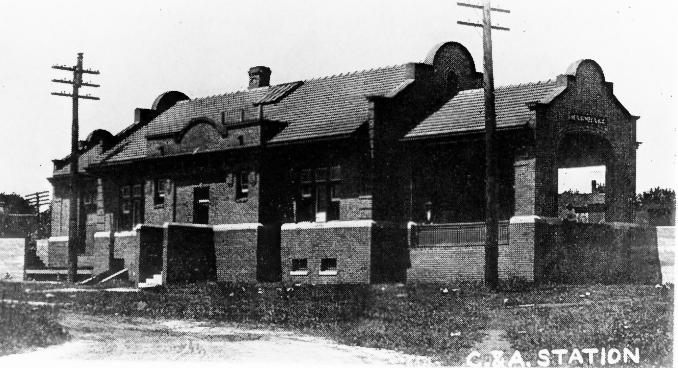Whitney Barnes
Staff Writer
If you’re heading north on Marshall, it’s hard to miss this distinctive building, whose current state gives it an eerie vibe: What once looked brand new is now scarred, its windows covered in worn wood planks, and graffiti hinting at vandalism.
It’s hard to imagine it wasn’t always this way, but it wasn’t: It once stood as a bustling Chicago & Alton Railroad station, bustling with activity and serving as a vital center of activity and connection.
The Chicago and Alton Railroad is known as the first railroad built in Saline county, its tracks reaching Marshall early in October, 1878, symbolizing a major development in the area.
On October 4, 1886, Marshall’s original Chicago & Alton Station (also known as the Illinois Central Bay Station) suffered a fire. Following this incident, passenger service was temporarily transferred to a freight station.
This historic train station was built in 1906 to replace one that had burned down ten years earlier. It was designed by renowned architect Jarvis Hunt and built by local contractor E.R. Page. The station was constructed using the finest materials available; its exterior is a mix of red brick and stone, a blend of Jacobean Revival and Mission styles, and has remained largely unchanged since its construction.
The station building is approximately 113 feet 2 inches long and 42 feet 11 inches wide at its widest point. It originally had a clay tile roof but is now shingled. At each end of the building are curved cement steps that once led visitors from ground level to the brick waiting platform. Inside the station were a cargo hold and baggage area at the west end for storing travellers’ luggage, and a passenger pavilion at the east end. The central part of the building contained a waiting room and ticket office and was the hub of activity in its heyday.
Today, this historic train depot serves as a tangible reminder of the enormous impact the Chicago and Alton Railroad Company had on the economic development of Saline County. The expansion of Saline County communities was closely linked to the westward expansion of the railroads. Several “railroad towns” sprang up, including Norton, Shackelford, Gilliam, Blackburn, Mount Leonard and Slater.
The town of Marshall experienced significant growth after the arrival of the C & A Railroad. Founded in 1839 by immigrants from Virginia, Tennessee and Kentucky, Marshall (the county seat of Saline County) initially grew slowly due to its inland location. The town’s growth was further hindered by the hardships of the Civil War, and by 1870 Marshall’s population was just 924. However, just three years after the C & A Railroad arrived in 1881, the population had soared to 3,000.
Unfortunately, the Chicago and Alton Railroad ran into financial difficulties and, to avoid bankruptcy, was purchased by the Baltimore and Ohio Railroad in 1929. The Baltimore and Ohio Railroad continued to operate the line until 1947, when it was sold to the Gulf Mobile and Ohio Railroad.
Passenger service continued to decline, with the last passenger train passing through Marshall on Friday, April 15, 1960. However, GM & O continued to use the station for freight.
In 1973, the railroad was sold again, this time to Illinois Central Gulf Railroad, a subsidiary of Illinois Central Industries. Within a few years, ICG ceased all operations at the Marshall Depot, and by the fall of 1977 it was only occasionally used by local freight train dispatchers. In 1978, all operations at the depot ceased. No information could be found regarding the ownership of the train depot beyond ICG in 1979. Marshall residents Paul and Kim Thompson purchased the property about 15 years ago and still own it today.
Asked about the future of the train station, Kim Thomspon said she had had several ideas over the years, but her original dream was to turn it into a restaurant.
“We thought many times about what type of restaurant we wanted,” she says, “whether to have a fancy sit-down restaurant or an old-fashioned diner. Ultimately, we wanted a restaurant that was affordable for everyone. We thought that a great historic place should be a place that anyone can easily experience.”
Thompson said the property ended up being put on the back burner for years as the couple focused on other business ventures, one of their projects including reopening the old B&B Theatre in Marshall.
“Keeping the movie theater open seemed like the more appropriate thing to do at the time,” she said. “We still talk about it periodically, and we hope that one day it will become a place where people can go to explore Marshallese history.”
Thompson said potential buyers for the building had been approached at least 10 times over the past 15 years, but no deals had materialized.
“We have never put the building up for sale but were always open to offers so that if someone else had the time and funds they could renovate the building without us,” she said. “The interior is basic and would require a significant financial investment so once they realised how much work was needed no one made an offer to buy it.”
Its fate seems uncertain, but looking back it is clear that the building played a pivotal role in shaping the town’s identity: without its past existence the city may not have developed into what it is today.
The Old C & A Train Depot is located about four blocks north of downtown Marshall on the north side of Sebree Street. This landmark was listed on the National Register of Historic Places in 1979.
Some information in this article was found on the original National Register of Historic Places Inventory-Nomination Form completed on April 3, 1979 by Donna M. Gibbs, president of the Saline County Historical Society.


